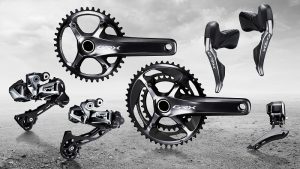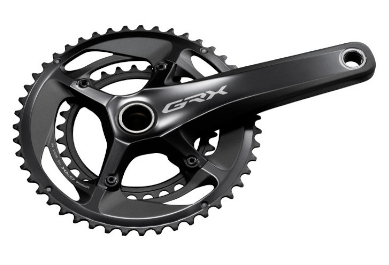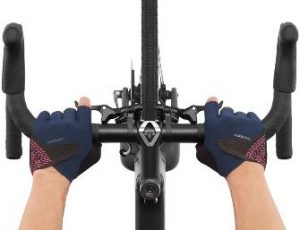Shimano GRX800 – A Review of Shimano’s Gravel Group
 Shimano introduced their first “gravel specific” group over a year ago, so writing about Shimano GRX 800 is not new news. This being said, we wanted to get a little time with the new Shimano GRX 800 components before providing an overview. With this in mind, here is what GRX does and doesn’t do after being out for a bit over a year.
Shimano introduced their first “gravel specific” group over a year ago, so writing about Shimano GRX 800 is not new news. This being said, we wanted to get a little time with the new Shimano GRX 800 components before providing an overview. With this in mind, here is what GRX does and doesn’t do after being out for a bit over a year.
The “gravel group” parts from Shimano are designated GRX and are available in three levels – 400, 600 and 800. 400 is a 10 speed group that is comparable to the Tiagra level of road components. 600 is parallel to 105 and 800 to Ultegra. Seeing as Ultegra is the “sweet spot” for many on the road, we expect Shimano GRX800 to be the most popular level of GRX for our clients. Shimano GRX800 is available in electronic Di2 shift version and mechanical shift and 1x and 2x formats. It is of note that GRX800 1x is Shimano’s first foray into a 1x system designed for a road oriented bike. It will be interesting to see where Shimano takes this in the future.
Without further ado, here are some of the highlights and notes on the intriguing GRX 800 groups from Shimano.
Shimano GRX 12 Speed?
Prior to release, it was anticipated that Shimano’s new GRX group was to be their first foray into 12 speed on a road bike. Shimano kicked that can down the road though; 2022 Dura Ace looks like the most likely place where we’ll see 12 speed rear cassettes on a Shimano equipped road bike.
While GRX being 11 speed may have come at the expense of a 10 tooth cog as is often used in 12 speed groups, it is hard to fault how well most of Shimano’s 11 speed systems currently perform from a mechanical perspective. Staying with 11 speed also offers more potential for GRX to be used with some components from other existing Shimano road groups (Ultegra in particular…). It is also worth noting that there are ways to use a 10 tooth cog with GRX if desired (see below).
Shimano GRX 2x Gearing Options
Out of the box, GRX810 2x cranks provide three teeth lower in the front than Ultegra compact (31 instead of 34 teeth). This is almost 2.5 gear inches lower. We welcome Shimano to the sub-compact offerings on the market.
Shimano offers GRX 2x in both Di2 (GRX815) and mechanical (GRX810) shift options. Out of the box, front gearing is 48/31 mated with an 11-34 cassette.
It is worth noting that the GRX600 crankset uses 46/30 rings and is geared lower than the GRX810 crankset.
Shimano GRX Crank Length Options
At this time, Shimano offers GRX810 cranks in 170, 172.5 and 175mm. The lack of a 165mm is a large hole in the offerings. Thankfully, the GRX600 crank with 46/30 gearing is available in a 165mm and is cross compatible, albeit at the expense of about 100 grams of weight. Hopefully Shimano will expand crank length offerings in the 800 level over time to cover shorter lengths.
165mm and is cross compatible, albeit at the expense of about 100 grams of weight. Hopefully Shimano will expand crank length offerings in the 800 level over time to cover shorter lengths.
Shimano GRX 1x Gearing Options
Shimano GRX 817 Di2 and GRX 812 mechanical shift are the 1x offerings. They offer a 40T or 42T chainring that can be mated with a 11-40 or 11-42 in the back. This provides slightly lower gear possibility than Ultegra’s current 1:1 ratio. However, you have to give up at least eight teeth on the high end for the simplicity of the 1x compared to Ultegra. It is in the 1x option where the lack of a 10 tooth cog, like SRAM uses on their XDR cassettes, can be a liability for those riders concerned about top speed.
“Hybrid” Gearing Options
It is worth noting that, while Shimano does not endorse it, we have evidence that SRAM XD 11 speed cassettes with 10 tooth small cogs play pretty well with GRX in many cases. This allows a 40 tooth front chainring to be mated to a 10-42 cassette in order to get below 1:1 on a 1x GRX drivetrain while gaining back some of the lost high gearing.
Likewise, depending on the frame the components are installed, Shimano rear derailleurs frequently accept cassettes that are two teeth bigger than the max capacity listing without much protest on many bikes. This would mean that on GRX 2x, a 46/31 can be paired with a 11-36 on many bikes, providing a low gear of 31-36. If you switch to the GRX600 crank, you can even get a 30T up front for the small chainring.
While GRX out of the box offers gearing that is definitely geared lower than Ultegra, pushing the system a bit with some retrofitting is where the opportunity lies for many in search of that “ultimate” gravel road gearing range. SRAM AXS 1x with an Eagle 10-50 (or 10-52) cassette is still the king of being able to go as low as possible with 1x. However, the jumps in the wide range Eagle cassettes are greater than some riders like; a modified Shimano system potentially fills this gap nicely.
It is worth noting that SRAM has some 2x new intermediary gearing competition for Shimano for those looking for below 1:1. See below…
SRAM Force Wide 2x Gravel Gearing Changes.
A rolling change to SRAM Force AXS options in the spring of 2020 rang in a nice intermediary gearing option between SRAM’s ultralow 1x MTB/Road hybrid AXS combination with a 10-50 cassette and their 2x AXS options that max out at 1:1. On 2x, SRAM is producing a Wide Force crank with a 43/30 and a new 10-36 cassette.
It seems that the golden age of gearing may be here. Shimano and SRAM are leapfrogging each other with options that meet just about everyone’s desires and needs.
GRX Front Derailleur Compatibility
Shimano GRX cranks kick the chainline out 2.5mm compared to their road groups. This increases tire clearance. Related, GRX front derailleur architecture is designed to accommodate this 2.5mm different chainline. It is recommended that GRX cranks be used with GRX front derailleurs for best performance.
While a really well adjusted and aligned SRAM AXS derailleur may give it a run for its money, Shimano’s 2x front shifting remains a benchmark.
Subcompact Crank Option for the Pavement Rider?
While GRX is designed as Shimano’s gravel group, the RX810 crankset with 48/31 gearing works well for many pavement riders as well. If you have wanted lower gearing that what your 105, Ultegra and Dura Ace group offers, a GRX crank and front derailleur could be just the ticket.
Otherwise, we expect the new RX810 crankset to sell really well for us as an aftermarket upgrade/change for riders pursuing lower gearing. As mentioned earlier, the 105 level RX600 crank takes this concept 1 tooth lower by offering a 46/30.
GRX Shift Levers Ergonomics
 Others have stated it, and we concur, the new GRX hoods have a nice feel that has more definition and a more “planted” and supported feel than other Shimano levers. Many will prefer it to other Shimano road levers they have used in the past. The ergonomics are good enough that we have encouraged some manufacturers to consider pairing the new GRX lever with their Ultegra road offerings too. This would help them reduce the number of shifters they need to stock while potentially offering a lever feel that many will prefer to the current Ultegra lever.
Others have stated it, and we concur, the new GRX hoods have a nice feel that has more definition and a more “planted” and supported feel than other Shimano levers. Many will prefer it to other Shimano road levers they have used in the past. The ergonomics are good enough that we have encouraged some manufacturers to consider pairing the new GRX lever with their Ultegra road offerings too. This would help them reduce the number of shifters they need to stock while potentially offering a lever feel that many will prefer to the current Ultegra lever.
It is worthy of note that the mechanical shift RX810 shifter and the Di2 electronic shift RX815 feel significantly different from each other. The mechanical shift lever has more rounded lines and a longer reach to the lever while the Di2 version is more compact with a convex lower and more angular feel. The Di2 lever is 12-14mm shorter than the mechanical version of the GRX810 lever, which is a big number from a bike fit perspective.
The Di2 RX815 levers also use a higher brake lever pivot location (18mm higher) to increase leverage. The higher brake lever mount is not found on the mechanical RX810 levers.
While many media sources have reported that GRX levers are the first drop bar levers Shimano has produced with ServoWave, this is not the case. All of Shimano’s prior hydraulic drop bar based shifters list ServoWave as a feature.
Clutch Equipped Rear Derailleurs
Up until GRX, the only Shimano rear road derailleur to have a clutch was the late edition Ultegra RX. Shimano continues to recognize that chain slap can be an issue when

riding rough roads as well as trails. GRX 800 rear derailleurs includes a switchable clutch.
In-Line Brake Lever Option
Shimano is making a GRX in-line bar top brake lever (GRX BL-RX812) that can be added to GRX shift levers for those desiring bar top hydraulic brake levers. These levers do have their place and are a nice option for riders who like to spend a lot of time on the top of the handlebar.
Dropper Post Lever & Other Shifter Options
The GRX 800 1x shifter set has an option to actuate a dropper post from the left shift lever. For technical off-road gravel riders (or those just looking to make it easier to get their bike in their car…), this is a nice option. This feature is compatible with cable actuated droppers where the head of the cable is located at the shift lever. STI levers that offer this feature are designated “LA” (RX-810-LA).
It is worth noting that another option with the Di2 levers set-up 1x, is to reprogram the left levers to shift the rear derailleur one way and the right levers to shift it the other (a la SRAM eTap). This puts the otherwise useless left Di2 lever to good use and can make shifting with heavy gloves easier.
Shimano GRX 800 Power Meter
SRAM AXS cranksets now offer the ability to have a factory power meter included from the factory or added to the crank later. At this time, Shimano is not offering a GRX 800 crankset with a power meter. This being said, Stages, among others, can install a power meter on a GRX crankset and offer compatible power meter options for GRX.
Shimano GRX 800 Impressions
From our perspective, the three biggest stories regarding Shimano GRX are as follows:
- Lower Gearing Options. We are really glad to see Shimano continue to expand their lower gearing options for drop bar bikes. While living in a hilly area may skew our perspective on gearing, people are still asking for lower gearing options. Albeit with a new front derailleur in some cases, the fact that GRX cranks will work with Shimano’s pavement groups in many cases is a big benefit. It is nice to see Shimano provide some additional gears; we hope they will continue to expand that.
- New Lever Architecture. The new GRX levers are ergonomically different from Shimano’s other road levers. We are not going to be surprised to see some of the new ergonomics trickle over to the next generation pavement groups. Again, like the crank, it is nice to see some cross-compatibility between GRX and road.
- 1x for Road. We’ll see where this leads, but Shimano is building a 1x road group now.
The surprise with GRX is the lack of a 12 speed option – especially on the 1x. On 2x, the gearing range of a 46/30 with a 10-36 would have made Shimano the clear leader in the gearing department. The “Wide” additions to SRAM Force in the spring of 2020 provide this exact gearing option.
This being said, it is great to see that many GRX parts will work with existing Shimano 11 speed road groups.
On the groups we’ve been able to build to date, GRX maintains Shimano’s hard-to-fault smooth and precise shifting. The gearing options are the broadest Shimano has offered on a road group to-date and the new lever ergonomics are some of the best available. GRX takes everything that Ultegra offers and increases the range of climbing gears.
The bottom line is that Shimano GRX 800 is the easy choice for many riders wanting to go with mechanical shifting. Campagnolo’s Eker is its only real competition right now and Ekar is 1x only and not found on that many OEM spec bikes. When it comes to electronic shift, SRAM Force Wide with 12 speeds and wireless activation provides GRX815 Di2 some more than valid competition. These two groups will continue to split the majority of the market. Regardless, it is nice to see Shimano make a true gravel bike group. We expect to see the GRX line become a mainstay in Shimano’s offerings and that will likely become their best selling group in hilly areas that have a lot of dirt roads.

